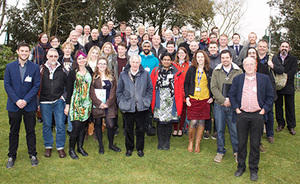A guide to inspire and enable higher education institutes to take action on biodiversity has been launched from the University of Worcester.

The Environmental Association for Universities and Colleges (EAUC) has created the practical guide to encourage and assist institutions in their work on tackling biodiversity, which it launched during an event at Worcester.
Over 50 students, academic staff, grounds staff and sustainability professionals from 23 higher education institutes including Oxford, Nottingham, Southampton and Leeds attended the launch.
The Biodiversity on Campus Guide contains information for grounds and maintenance staff through to environmental and senior estates managers. The guide is also useful for any student and member of staff at universities or colleges involved in biodiversity initiatives.
The University of Worcester's Dr Duncan Westbury, Senior Lecturer in Ecology & Environmental Management, informed delegates from the EAUC on the University's approaches to creating and managing wildflower areas.
managing wildflower areas.
The University of Worcester has previously been a recipient of the EAUC's Green Gown Awards, which recognise exceptional sustainability initiatives undertaken by universities and colleges in the UK, taking home the top prize in the Facilities and Services class for its bike loan scheme in 2014.
The University has also been working with Professor Tim Shreeve, Director at the Centre for Ecology Environment and Conservation from Oxford Brookes, to test a new tool for its suitability to map student houses as part of the Worcester Students" Union-led project, Energize Worcester. This project is looking, in its final research phase, at student and landlord habits on setting the heating temperature and how this is negotiated by students who share a house.
Katy Boom, Director of Sustainability at the University said "At the launch conference staff and students led campus tours to showcase our key achievements in biodiversity so far. Plans and development in biodiversity for the future are also already in place with schemes including the installation of Bee Hotels and Bird Boxes as well as creating wildlife strips. Students have also been mapping all the green areas on site in order to enable them to set realistic and sustainable biodiversity targets for the future."